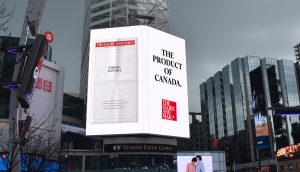The issue of rampant irregularity in Toronto’s out of home signage industry continues to get attention as volunteer-based IllegalSigns.ca persists in its agenda of providing updates on who’s who in the business of ‘illegal’ billboards.
Industry movement to respond to the list has been less speedy. Toronto-based Out-of-Home Marketing Association of Canada (OMAC), which represents the interests of some of the country’s largest OOH companies, urges its members to follow the appropriate regulations. However, OMAC president Rosanne Caron says she can’t comment on specific claims made about irregularities, as the organization is still waiting for city officials to provide a comprehensive list of its members’ violations of local sign bylaws. That request was made in 2006.
The problem hit the press last summer, when councillor Kyle Rae stepped forward to address the issue, and more recently has been getting ongoing scrutiny since IllegalSigns.ca announced its public efforts to aid the city in cracking down on ‘illegal advertising’ (see MiC‘s Feb. 12 story, Activist website launches to I.D. Toronto’s ‘illegal’ billboards). The site claims some signs are going up without proper permits, new ads are being mounted too close to existing ads, some are too big or unsafe, and others are made using vinyl wall murals where permits were granted for non-illuminated, painted signs.
‘I can’t really comment on that website (IllegalSigns.ca), because I don’t know where the information is coming from or whether it’s accurate,’ Caron tells MiC. ‘OMAC member companies are working with the city when there are issues, as they come up, and we’re trying to deal with them. Until I actually get that list and review it and evaluate which ones (apply) to my members, there’s not really anything we can do.’
Meanwhile, some OOH media companies have taken the bull by the horns. The Outdoor Task Force, a joint effort by Toronto’s Strategic Media and Abcon Media, submitted a proposal to the City of Toronto in June 2006 that outlines a new sign permit protocol. Part of that proposal pushes for the implementation of an annual licence fee system that would see outdoor agencies pay a cost per square foot of signage area used in the city. Barcoded licences would be placed beneath every OOH execution, allowing for a barcode scanner to instantly read whether the display is to code and paid up. The proposal calls for self-governance among agencies and enforcement by the city.
Strategic Media director Daniel Pitoscia tells MiC the city’s sign bylaws need updating, whether the new legislation is based on the Outdoor Task Force’s proposal or not. ‘What we should be doing is adjusting some of these bylaws to take into account the fact that technology and the city itself have evolved over the last 20 years,’ he says.
Abcon Media president/CEO Les Abro says city officials have indicated changes to the sign bylaw will, hopefully, be implemented by 2008. The Outdoor Task Force’s idea to set up a system based on licencing has been publicly supported by councillors Kyle Rae, Joe Mihevic and Adam Giambrone. ‘It looks like we’ve got a lot of support,’ says Abro.
While Abro agreed that the problem of technically illegal OOH advertising is widespread in Toronto, he says the use of vinyl murals just makes sense for the ‘green’ age. ‘Let’s be honest. You go anywhere in the world today and every city has embraced vinyl banner advertising, as opposed to painted murals,’ he says. ‘Firstly, the paint is toxic and going into the atmosphere, and you can’t clean it off. The vinyl banner can be recycled, there’s no paint or toxic fumes going into the atmosphere, and the artists aren’t breathing the stuff in.’

















